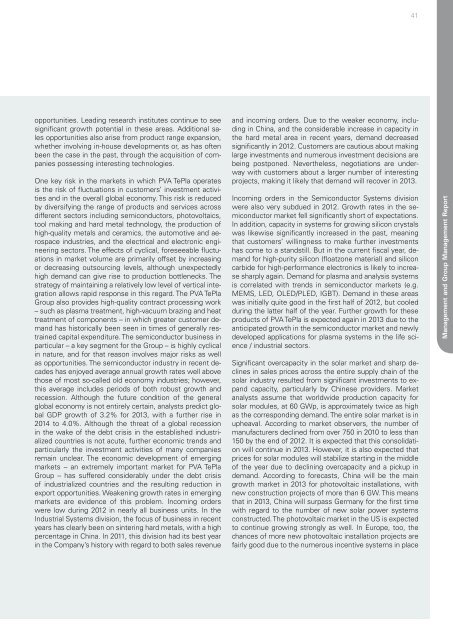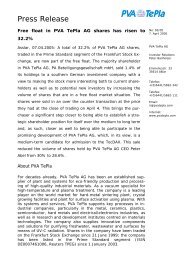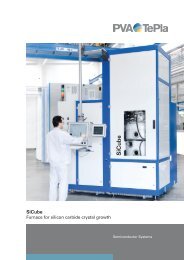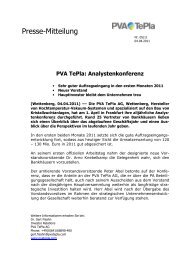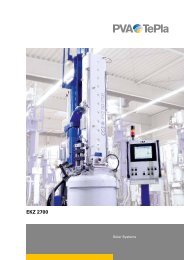Consolidated Annual Report 2012 and Single-Entity ... - PVA TePla AG
Consolidated Annual Report 2012 and Single-Entity ... - PVA TePla AG
Consolidated Annual Report 2012 and Single-Entity ... - PVA TePla AG
You also want an ePaper? Increase the reach of your titles
YUMPU automatically turns print PDFs into web optimized ePapers that Google loves.
opportunities. Leading research institutes continue to see<br />
significant growth potential in these areas. Additional sales<br />
opportunities also arise from product range expansion,<br />
whether involving in-house developments or, as has often<br />
been the case in the past, through the acquisition of companies<br />
possessing interesting technologies.<br />
One key risk in the markets in which <strong>PVA</strong> <strong>TePla</strong> operates<br />
is the risk of fluctuations in customers’ investment activities<br />
<strong>and</strong> in the overall global economy. This risk is reduced<br />
by diversifying the range of products <strong>and</strong> services across<br />
different sectors including semiconductors, photovoltaics,<br />
tool making <strong>and</strong> hard metal technology, the production of<br />
high-quality metals <strong>and</strong> ceramics, the automotive <strong>and</strong> aerospace<br />
industries, <strong>and</strong> the electrical <strong>and</strong> electronic engineering<br />
sectors. The effects of cyclical, foreseeable fluctuations<br />
in market volume are primarily offset by increasing<br />
or decreasing outsourcing levels, although unexpectedly<br />
high dem<strong>and</strong> can give rise to production bottlenecks. The<br />
strategy of maintaining a relatively low level of vertical integration<br />
allows rapid response in this regard. The <strong>PVA</strong> <strong>TePla</strong><br />
Group also provides high-quality contract processing work<br />
– such as plasma treatment, high-vacuum brazing <strong>and</strong> heat<br />
treatment of components – in which greater customer dem<strong>and</strong><br />
has historically been seen in times of generally restrained<br />
capital expenditure. The semiconductor business in<br />
particular – a key segment for the Group – is highly cyclical<br />
in nature, <strong>and</strong> for that reason involves major risks as well<br />
as opportunities. The semiconductor industry in recent decades<br />
has enjoyed average annual growth rates well above<br />
those of most so-called old economy industries; however,<br />
this average includes periods of both robust growth <strong>and</strong><br />
recession. Although the future condition of the general<br />
global economy is not entirely certain, analysts predict global<br />
GDP growth of 3.2% for 2013, with a further rise in<br />
2014 to 4.0%. Although the threat of a global recession<br />
in the wake of the debt crisis in the established industrialized<br />
countries is not acute, further economic trends <strong>and</strong><br />
particularly the investment activities of many companies<br />
remain unclear. The economic development of emerging<br />
markets – an extremely important market for <strong>PVA</strong> <strong>TePla</strong><br />
Group – has suffered considerably under the debt crisis<br />
of industrialized countries <strong>and</strong> the resulting reduction in<br />
export opportunities. Weakening growth rates in emerging<br />
markets are evidence of this problem. Incoming orders<br />
were low during <strong>2012</strong> in nearly all business units. In the<br />
Industrial Systems division, the focus of business in recent<br />
years has clearly been on sintering hard metals, with a high<br />
percentage in China. In 2011, this division had its best year<br />
in the Company’s history with regard to both sales revenue<br />
41<br />
<strong>and</strong> incoming orders. Due to the weaker economy, including<br />
in China, <strong>and</strong> the considerable increase in capacity in<br />
the hard metal area in recent years, dem<strong>and</strong> decreased<br />
significantly in <strong>2012</strong>. Customers are cautious about making<br />
large investments <strong>and</strong> numerous investment decisions are<br />
being postponed. Nevertheless, negotiations are underway<br />
with customers about a larger number of interesting<br />
projects, making it likely that dem<strong>and</strong> will recover in 2013.<br />
Incoming orders in the Semiconductor Systems division<br />
were also very subdued in <strong>2012</strong>. Growth rates in the semiconductor<br />
market fell significantly short of expectations.<br />
In addition, capacity in systems for growing silicon crystals<br />
was likewise significantly increased in the past, meaning<br />
that customers’ willingness to make further investments<br />
has come to a st<strong>and</strong>still. But in the current fiscal year, dem<strong>and</strong><br />
for high-purity silicon (floatzone material) <strong>and</strong> silicon<br />
carbide for high-performance electronics is likely to increase<br />
sharply again. Dem<strong>and</strong> for plasma <strong>and</strong> analysis systems<br />
is correlated with trends in semiconductor markets (e.g.<br />
MEMS, LED, OLED/PLED, IGBT). Dem<strong>and</strong> in these areas<br />
was initially quite good in the first half of <strong>2012</strong>, but cooled<br />
during the latter half of the year. Further growth for these<br />
products of <strong>PVA</strong> <strong>TePla</strong> is expected again in 2013 due to the<br />
anticipated growth in the semiconductor market <strong>and</strong> newly<br />
developed applications for plasma systems in the life science<br />
/ industrial sectors.<br />
Significant overcapacity in the solar market <strong>and</strong> sharp declines<br />
in sales prices across the entire supply chain of the<br />
solar industry resulted from significant investments to exp<strong>and</strong><br />
capacity, particularly by Chinese providers. Market<br />
analysts assume that worldwide production capacity for<br />
solar modules, at 60 GWp, is approximately twice as high<br />
as the corresponding dem<strong>and</strong>. The entire solar market is in<br />
upheaval. According to market observers, the number of<br />
manufacturers declined from over 750 in 2010 to less than<br />
150 by the end of <strong>2012</strong>. It is expected that this consolidation<br />
will continue in 2013. However, it is also expected that<br />
prices for solar modules will stabilize starting in the middle<br />
of the year due to declining overcapacity <strong>and</strong> a pickup in<br />
dem<strong>and</strong>. According to forecasts, China will be the main<br />
growth market in 2013 for photovoltaic installations, with<br />
new construction projects of more than 6 GW. This means<br />
that in 2013, China will surpass Germany for the first time<br />
with regard to the number of new solar power systems<br />
constructed. The photovoltaic market in the US is expected<br />
to continue growing strongly as well. In Europe, too, the<br />
chances of more new photovoltaic installation projects are<br />
fairly good due to the numerous incentive systems in place<br />
Management <strong>and</strong> Group Management <strong>Report</strong>


